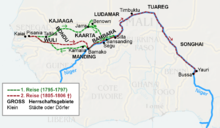Bondu
Bondu (other spelling Bundu , Bondoo or Bondou ) was a historical empire in the east of what is now the West African state of Senegal .
geography
The small kingdom was separated from the Bambouk to the east by the Falémé river . The southern border was formed by the upper reaches of the Gambia River . The upper reaches of the Sandougou delimited the kingdom in the west from the kingdom of Wuli .
The region between latitude 13 ° and 15 ° north and longitude 12 ° and 13 ° east consists today, as it was then, of a plateau with hills in the southern and central part. The hills are not very fertile and overgrown with stunted trees. In contrast, the valleys are fertile and overgrown with baobab trees , tamarind trees and various fruit trees. The region is traversed by numerous rivers that flow very quickly in the rainy season but mostly dry out in the dry season . Cotton , tobacco and indigo were grown in the empire, and iron ore and gold were found.
history
At the end of the 19th century, the population consisted of an estimated 30,000 inhabitants, predominantly of the Fulbe ethnic group , as well as Mandinka , Wolof and Soninke . The residents grew millet, rice, indigo and cotton and made cotton fabrics. Since Bondu was an important stopover on the way from the interior of West Africa to the coast, they also carried out a very considerable trade. The empire founded by Malik Sy in the late 17th century was a monarchical electoral empire under an Almamy , ruled theocratically .
The capital of the empire was Boulébané . According to reports from Major W. Grau , a British officer in the Royal African Company who was in Bondu in 1818, Bulibani (or Bulebane ) had a population of around 3,000 and was surrounded by a thick mud wall. According to a travel report from 1846, the place was about 24 kilometers west of Sénoudébou , where a French fort had been built in 1845. ⊙ There is no trace of the name Boulébané in the area in question. Because of the phonetic appeal, the village of Banipéli might come into question, almost 24 kilometers west-southwest of Sénoudébou and about an hour's walk behind the village of Youpé mentioned in the travelogue and still identifiable today . ⊙ At the end of the 19th century the population is given as 2000 inhabitants.
Although the Fulani clergy who ruled the empire were committed to the spread of Islam, they also admitted other faiths in the interests of internal stability. Foreign policy was primarily determined by the trade in agricultural goods; Bondu's policy was not to enforce Islam militarily.
In August 1845, the King of Bondu signed a treaty recognizing French sovereignty over his country. The treaty was initially disregarded by the people, but in 1858 Bondu finally came under French control. In 1905, Bondu was annexed by France and incorporated as a protectorate in the French colony of Senegal.
European discovery
The African explorer Daniel Houghton was probably the first European to tour the country around 1790. However, he died further inland in Ludamar , so there are no records of him. It was only when Mungo Park crossed the empire in 1795 that some of Bondu's descriptions were made public to the European public in his travelogue Travels in the Interior of Africa . At that time, according to his travelogue, Fatteconda was the seat of the ruler.
literature
- Michael A. Gomez : Pragmatism in the age of Jihad. The precolonial state of Bundu (= African Studies Series. 75). Cambridge University Press, Cambridge et al. 1992, ISBN 0-521-41940-9 .
- André Rançon: Le Bondou. Étude de geographie et d'histoire soudaniennes de 1681 à nos jours. G. Gounouilhou, Bordeaux 1894.
Remarks
- ^ Raffenel, Anne: Voyage dans l'Afrique occidentale, page 134. Paris 1849
- ↑ Bondu . In: Meyers Konversations-Lexikon . 4th edition. Volume 3, Verlag des Bibliographisches Institut, Leipzig / Vienna 1885–1892, p. 190.
- ↑ Bondu at: The American Forum for Global Education ( Memento of July 18, 2006 in the Internet Archive )

